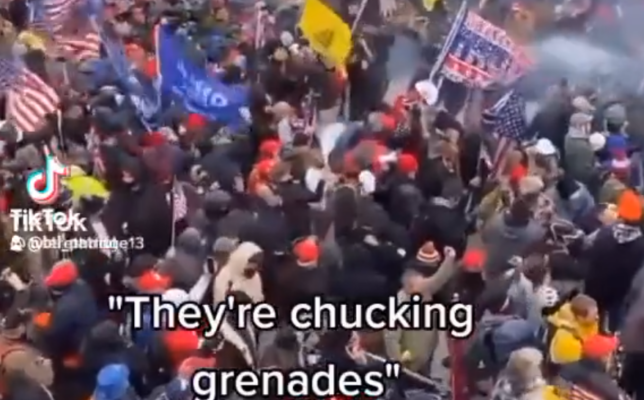I just happened to stumble upon this video on Twitter, and it’s not your typical cat meme.
Wonder why the J6 Committee never showed this video?
Watch as police throw 3 concussion grenades into a peaceful crowd
The man at the end says everything was peaceful until police did this
I’ve never seen cops throw flashbangs into peaceful crowds pic.twitter.com/VB1Zos1dVN
— DC_Draino (@DC_Draino) November 30, 2023
The video captures the unsettling scene of police hurling not one, not two, but three concussion grenades into an apparently peaceful crowd at the Capitol on January 6.
In this eye-opening footage, the peaceful atmosphere is shattered by the deafening blasts of concussion grenades.
It made me wonder, “Why hasn’t this been shown?”
It’s the kind of reality check that sends shivers down your spine. But here’s the kicker: the January 6 Committee, the supposed guardians of truth in the aftermath of the Capitol insurrection, has kept this video, and probably, many others, under wraps.
The Jan. 6, 2021, narrative was that the Capitol had seemingly turned into a battlefield, and the January 6 Committee was assigned to untangle the mess left after the insurrection.
How are we to make any sense of it all, with this video, a piece of the puzzle, showing police tossing concussion grenades into what looks like a peaceful crowd? But why did the January 6 Committee keep this nugget from us?
Lack of evidence – is that we are to understand? Because that’s the committee’s first line of defense. They’re on a mission to decipher what happened that fateful day, not a sideshow of unrelated incidents.
Fair enough, but how about this video and probably several others we haven’t seen to provide a sneak peek into the broader story? Did they leave stones unturned?
We can understand if the committee has to walk a tightrope, juggling legal standards and ethical norms. But this isn’t just any video – it clearly shows the police force, and this video, by itself, is the smoking gun, showing a pattern of aggressive tactics that fueled the chaos. Shouldn’t ethical concerns push them to expose potential misconduct?
Or maybe the committee wants the cold, hard facts. That is understandable, considering the gravity of the situation. But what if this video is a fact, a stark reality of how force was used that day? Does it not deserve a seat at the truth-telling table?
The committee might argue about the availability of other evidence or maybe just that other videos are more relevant and reliable. But what if this one is unique, capturing a moment of truth that others missed? Shouldn’t they explore every avenue to present a complete picture?
The January 6 Committee delved deep into emails, text messages, internal communications, depositions, and what-not. They claim they turned over every stone in their quest for truth.
But what about the video that could speak volumes without a single word?
As we navigate this maze of investigations, it’s not just about the committee. It’s about those who swore an oath to protect and serve, resorting to force against peaceful crowds. What consequences should they face?
If the use of force was unreasonable, criminal charges are on the table. But what if these charges are the exception, not the rule? Do we need a systemic shift in how we evaluate the use of force?
Officers can be held accountable for damages by way of civil lawsuits. But accountability isn’t just about compensating victims – it’s about redefining the relationship between the police and the people they serve.
Citing internal investigations, departments can have their internal checks. But these investigations might resemble something of a fox guarding the henhouse. Should external scrutiny be the norm?
True, videos can shape public perception. And we can’t just brush them aside, saying that such snippets lack context. And it is prerogative that we look to the complaints from other officers – fellow officers, as the whistle-blowers, overcoming the code of silence that might prevail. Shouldn’t we foster an environment where speaking up is the rule, not the exception?
We should – with “professional consequences,” which are violators losing benefits or even getting terminated. But what if the consequences aren’t consistent across the board? Shouldn’t justice be impartial to the badge?
As we grapple with these questions, no doubt, the January 6 Committee stands as a symbol of our collective pursuit of truth. But in their quest, let’s not forget the videos like this that might hold the missing pieces. It’s not just about the events of January 6; it’s about the lessons we learn and the changes we demand. Ultimately, it’s about reclaiming a sense of justice that extends beyond the hallowed halls of the Capitol.
